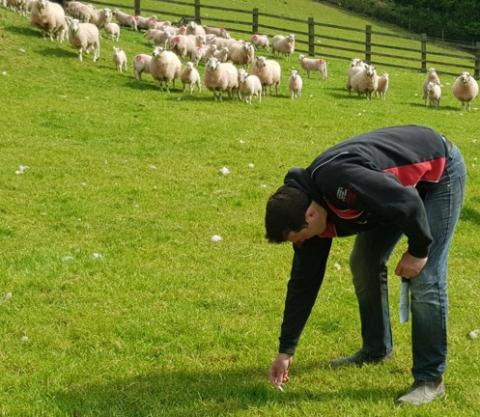Targeting anthelmintic use in sheep
The application of enhanced monitoring, contamination mapping and modelling to reduce reliance on anthelmintics through more targeted treatments.
Farmers are becoming increasingly better at targeting anthelmintic treatments for lambs to achieve good growth rates without compromising the efficacy of the wormers. However, treatments for ewes are often given routinely around lambing because of the risk from ewes of contaminating grazing pastures with worm burdens that they may carry. This project investigated the patterns of infections in the ewes around lambing time, known as the peri-parturient rise (PPR), to ensure treatments are targeted at the optimum time and with the most appropriate product.
Six sheep farmers based in mid and south west Wales worked together on the project to develop roundworm treatment plans for their ewes in the lead up to, and shortly after lambing. Their objectives for this project was to minimise the risk of ewe and lamb parasitic infections, improve lamb growth rates, and reduce their dependency on anthelmintics.
Project activities
- The project ran from December 2019 to June 2022.
- Each farmer chose a group of about 100 ewes each year (grazing on the same field) that were monitored throughout the peri-parturient period.
- A mob FEC sample was taken from the ewe group for analysis on a weekly basis from 6 weeks before until 6-8 weeks after lambing.
- Speciation tests were carried out on a sub group of ewes to know what worms were present on each farm.
- This allowed a graph to be drawn up showing the peri-parturient rise of parasitic worm burden in the lead up to, and shortly after lambing for each farm.
- Ewe BCS and weight were monitored from 6 weeks before to 6-8 weeks after lambing.
- Lamb weights were measured at 56 and 90 days old and worm burden levels were recorded to assess the impact on health and productivity.
Project outcomes:
- The PPR varies between farms in both extent, timing and duration. Sheep farmers therefore need to monitor their flock to find out what the pattern is on their farm in order to choose the most effective time to administer any treatments to ewes.
- Mob and sentinel FEC results were generally in good agreement, which supports the use of a mob FEC as a monitoring tool (providing the samples are taken according to best practice).
- In this project it was the change (reduction) in BCS that was the indicator of an increased FEC.
- Selecting the ewes most likely to be responsible for a high proportion of the pasture contamination (those with a high egg output) relies on being able to find those that lose BCS at the time when the flock is under nutritional pressure.
- Simply using litter size and a set time (e.g. at lambing) as a guide as to which ewes to treat and when is not accurate enough, farmers should be advised to monitor FEC levels in ewes in the run up to, and after lambing in addition to following BCS changes in order for them to decide when is the right time to treat.

